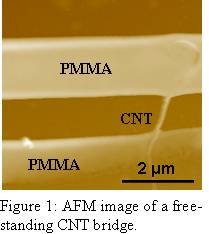AmericanChemicalSociety.com
Reports: DNI7 49795-DNI7: Investigating Interfacial Stress Transfer in Carbon Nanotube-Reinforced PMMA Polymers
Changhong Ke, PhD, Binghamton University
Our research progress from this PRF support also includes the
mechanical testing of carbon nanotubes and the interfacial binding interaction
among tubes in the bundle structure and between nanotube and substrate. Our research results reveal that the
interfacial interaction between nanotubes can have a significant impact on its
mechanical deformation, including the adhesion-driven buckling. Our research
also reveals that the interfacial interaction between the CNT and the substrate
is strongly modulated by the deformation of the CNT. These results, which were reported
in two peer-reviewed journal articles, are very useful to the understanding of the
interfacial binding interaction in 1D nanostructures and the pursuit of
adhesion-involved applications, including polymer composites.
In addition to the study of the interfacial stress transfer
between PMMA and CNT, we are pursuing new research direction to study the
interfacial stress transfer between polymer and graphene sheet, which is a key
and challenging issue for the emerging graphene-based polymer composite. This
new research direction is a direct extension of the research work supported by
this PRF grant. The manufacturing
process that we demonstrated for engineering free-standing CNT bridges is
currently being applied to fabricate free-standing graphene sheet with one end
embedded into the polymer. The interfacial shear strength between the graphene
and the polymer will be characterized by in-situ SEM nanomechanical testing
which utilizes a flexible AFM cantilever as force sensor. Our experimental measurements will be
interpreted by molecular dynamical simulation through an established
collaboration with Dr. Rajesh Khare at  The
goal of this project is to investigate the interfacial stress transfer between
PMMA and embedded individual carbon nanotubes (CNT) in CNT-reinforced PMMA
polymers. Our approach is to first engineer doubly-clamped CNT bridges with
both ends fully embedded into the polymer (PMMA). The interfacial stress
transfer between PMMA and the embedded CNT will be obtained by atomic force
microscopy (AFM)-based pull-out experiments. The key challenge of this research
is the preparation of free-standing CNT bridges that are suited for the AFM
pull-out measurements. We have made significant progress in the preparation of
free-standing CNT bridges, as exemplified by the AFM image shown in Figure 1.
The CNT bridge was formed by three spin-coating processes: (1) a polymer layer;
(2) a diluted CNT layer; (3) another polymer layer, which was followed by
patterning of the polymer layers using photolithograph. Our next step research
work is to fine-tune our fabrication process to significantly increase the
yield of the free-standing CNT bridges and to perform the AFM pull-out measurements.
In addition to the CNT bridge preparation, we were also making progress on the
fabrication of the focused-ion beam (FIB) modified AFM probes, which are needed
for the AFM-based pull-out test. For the time-being, two FIB-modified AFM
probes have been manufactured and are available for our pull-out tests.
The
goal of this project is to investigate the interfacial stress transfer between
PMMA and embedded individual carbon nanotubes (CNT) in CNT-reinforced PMMA
polymers. Our approach is to first engineer doubly-clamped CNT bridges with
both ends fully embedded into the polymer (PMMA). The interfacial stress
transfer between PMMA and the embedded CNT will be obtained by atomic force
microscopy (AFM)-based pull-out experiments. The key challenge of this research
is the preparation of free-standing CNT bridges that are suited for the AFM
pull-out measurements. We have made significant progress in the preparation of
free-standing CNT bridges, as exemplified by the AFM image shown in Figure 1.
The CNT bridge was formed by three spin-coating processes: (1) a polymer layer;
(2) a diluted CNT layer; (3) another polymer layer, which was followed by
patterning of the polymer layers using photolithograph. Our next step research
work is to fine-tune our fabrication process to significantly increase the
yield of the free-standing CNT bridges and to perform the AFM pull-out measurements.
In addition to the CNT bridge preparation, we were also making progress on the
fabrication of the focused-ion beam (FIB) modified AFM probes, which are needed
for the AFM-based pull-out test. For the time-being, two FIB-modified AFM
probes have been manufactured and are available for our pull-out tests.
Copyright © American Chemical Society

